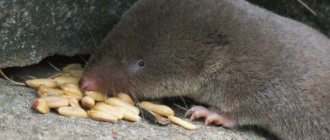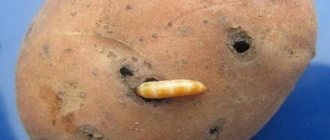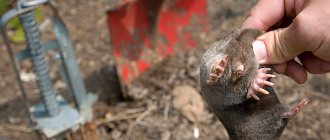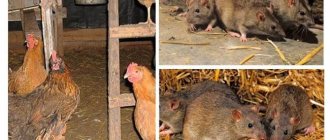Causes of rodents
Various types of rodents, just like insects, can settle next to a person and cause him a whole lot of inconvenience.
It is often not so easy to remove them, since these pests try to avoid direct contact with people, adapt to virtually any living conditions, and also constantly learn not to fall into traps and recognize poisoned food.
Before you begin to destroy such unwanted neighbors, you must first find out the possible reasons for their appearance in order to avoid relapses in the future.
Most often, their appearance is accompanied by the following factors:
- The presence of food and various edible supplies that are stored in places that are accessible to mice. It is worth noting that storing food in bags and even hanging cabinets is not considered a sufficient degree of protection, since such obstacles are not insurmountable for rodents.
- Violation of sanitary standards in the premises, which can be expressed in rare garbage removal, leading to its accumulation in large volumes, as well as extremely rare cleaning. All these factors create a favorable environment for rodents to live in, since among the waste there is almost always food suitable for them.
- Favorable temperature conditions, this factor becomes most relevant with the onset of winter cold, when mice are ready to sacrifice their own safety for the sake of moving to warmer places, including human homes.
- Mass migration of rodents, which can begin due to the fact that someone nearby began to purposefully poison and exterminate them.
Traditional methods of fighting
The easiest way to get rid of rodents is to get a cat. This is a natural enemy of rodents that preys on them. In addition, mice and rats simply cannot stand the cat spirit, so they will stay away from the house and area with cats. In some cases, it is enough to bring cat litter into the house, and it will repel rodents with its smell.
The problem is that not all cats are hunters. There are individuals who flatly refuse to catch rodents or are even afraid of them. In addition, the owners may be allergic to the cat. By the way, hunting dogs also hunt mice and rats.
In addition to pets, mousetraps and glue traps can be used to kill rodents. The familiar mousetraps crush the animal, and they stick to the glue, cannot budge and die. It’s convenient to smear glue on a plastic bag, and when the rodent gets caught and dies, just wrap it in the bag and throw it away. Glue for traps or ready-made glue traps is produced by the domestic company MediLIS. The advantage of this product is that the glue retains its properties and does not dry out for two weeks.
But the listed rodent repellents only work in small quantities. If there are a lot of mice and rats, mousetraps and traps are not very effective.
Why is the neighborhood of rats dangerous for humans?
Rats are the most dangerous natural reservoir of many anthroponotic (dangerous to humans) and zoonotic (dangerous to animals) infections: rabies, leptospirosis, plague, toxoplasmosis and other diseases. Ectoparasites of rats (rat flea, rat mite), often leaving the host, can not only transmit infection, but also cause severe allergic reactions.
These large rodents can harm not only a person’s physical but also mental health, causing severe panic attacks in some people.
Rats not only eat, but also spoil food, animal feed supplies, and seeds stored for sowing, causing significant damage to the farm. They chew everything they can get their hands on: furniture, partitions, foundations and walls of the house. Of particular danger is the ability of rats to chew electrical cables and wiring, which can lead to a fire.
At the first sign of rodents in the house, it is necessary to begin fighting them, as they multiply very quickly.
It is necessary to immediately assess the size of the disaster:
- identify infested premises (house, barn, garage, chicken coop). The best ways to control rats in a chicken coop;
- find out the location of rat holes, identify places where rodents accumulate, as well as their routes of movement;
- choose the safest method of getting rid of pests.
If the number of pests is small, folk remedies for rats are quite suitable.
Chemical methods
The essence of chemical methods of deratization is the poisoning of rodents with toxic substances - rodenticides (from the Latin rodentis - gnawing and caedo - I kill). These substances act when they enter the intestines or lungs (fumigants). The forms of use of deratization drugs are varied. These can be powders consisting of a single drug or a mixture of poison with various inert fillers (talc, starch, road dust, etc.), solutions and suspensions, fat-based pastes, waxed briquettes, biscuits, breadcrumb mixtures and etc. According to the nature of their origin, poisons are divided into plant and synthetic. Numerous drugs of synthetic origin are most widespread throughout the world. All synthetic rodepticides are combined into two large groups, each of which is characterized by the specific action of its constituent drugs on the animal body: these are drugs of acute and chronic action (anticoagulants).
Acute poisons cause the death of rodents after eating the bait once. These include: sodium cremiefluoride, barium carbonate, arsenic compounds, yellow phosphorus, zinc phosphide, thallium sulfate and other inorganic compounds, as well as organic plant poisons: strychnine, scylliroside (red sea onion preparation), sodium fluoroacetate (1080); organic synthetic poisons: ratsid, thiosemicarbazide, promurit, fluoroacetamide, barium fluoroacetate, monofluorine, glyftor, shoksin (norbomide), vacor (RH=787), etc.
Poisons of chronic (cumulative) action are characterized by a long latent period, slow development of the poisoning process with regular administration of very small doses into the body. These drugs cumulate (accumulate) in the animal’s body and gradually lead to significant biochemical and pathological changes and death. The largest proportion among chronic poisons are blood anticoagulants from the coumarin group: warfarin (zoocumaria), coumachlor, dicumarol, etc.; and indadione: diphenacin, fentolacin, etc. Currently, the following methods are widely used in deratization practice: 1) food poisoning baits - poison is mixed with a food product that is quite attractive to rodents; 2) liquid poisoned baits - the use of solutions or suspensions of poisons in water, milk and similar liquids; 3) pollination - the use of powdered poisons for pollination of exits from burrows, paths and paths of movement of rodents, nesting material, etc.; 4) gassing - supplying poisons in a gaseous state to a room or burrow of rodents.
Poison for mice and rats kills rodents in their shelters, and after a while the characteristic smell of rotting organic matter, emitted by the corpses of dead pests, begins to spread in the room, which poses a health hazard. One problem gives way to another. Sometimes, in order to clean a room, you have to open the floors or wall cladding, and so on with every rodent infestation. We should also not forget that poison against rats is a source of danger for humans, domestic and wild animals.
Electronic methods do not have the disadvantages of the above methods of rodent control.
Why do rodents appear?
In the summer they feel great outside, but with the arrival of the first cold days they begin to look for shelter for the winter. The best option for animals is human housing and outbuildings, where it is not only warm, but also has food supplies. A house with a large mouse colony already living next to it is more likely to be attacked by tailed animals.
Animals start and quickly multiply where there is food supply for them: garbage dumps, livestock farms, shops, public catering facilities, abandoned buildings, etc. Their numbers are growing rapidly, space is becoming scarce, so rodents are exploring new territories.
Why are mice dangerous?
In general, “neighborhood” with rodents can even result in severe infections for humans - these are sources of rabies, leptospirosis, toxoplasmosis, parasitic diseases, hemorrhagic fever, tularemia, plague, typhoid, cholera and other infectious diseases that, if not diagnosed in time, can be fatal . In addition, mice can become a source of fleas and infect your pets.
They carry this infection on their paws, while being a reservoir, the mice themselves do not suffer from these infections. Infection is possible through contact - bites, contact with a corpse, inhalation of air and dust in a room where there is a high number of rodents - they contain particles of hair and mouse droppings, which can cause not only infection, but also allergic reactions.
There is also a high risk of contracting an infection when drinking water containing mouse feces. The alimentary route (through the mouth) can also occur when eating food that has been walked on by rodents - this is how they will bring an infection to their paws.
What is the best rat and mouse repeller?
There are several methods to repel dangerous rodents, for example:
- various odors that rats cannot tolerate.
- ultrasonic devices.
- special materials and special plants.
The worst smell for rats is burnt fur. With its help you can scare away both earth rats and water rats. There is no need to burn the wool in the chicken coop itself or in another building; it is enough to simply bring several pieces of pre-scorched wool into it, for which, in addition to natural wool, pieces of unnecessary fur are also suitable.
Plants used to repel such rodents are mainly those whose seeds have spines and can stick to the skin, for example, burdock or black root. Rats are unable to comb such thorns out of their fur themselves, and therefore do not make holes where these plants are present.
If you scatter ash on the floor of the chicken coop, rodents will quickly leave this room. The reason for this is simple - ash is a fairly caustic alkali. Particles of ash fall onto the animal’s fur, and when licked, into the digestive system, which creates a lot of suffering for the rodent.
Signs of mice in the house
The main ways from which uninvited guests can enter your home are the basement, sewers, ventilation pipes, and garbage chutes. There are direct signs that mice have entered your home:
- Holes in walls and floors are passages that rodents need to move freely around the apartment;
- Mouse droppings are small black oblong feces;
- The smell is sour and musty, easily recognizable;
- Sounds – if during the day mice can make a slight rustling noise when moving, then at night, especially if there are large concentrations of them, quite loud sounds can occur under the floor and behind the walls, accompanied by a characteristic mouse high-pitched squeak;
- Wary behavior of a cat - if the pet constantly sniffs and looks for something, freezes in one place for a long time - perhaps he is hunting for mice, the presence of which you do not even suspect.
How plants can help
Many hardware stores now offer a wide range of generic rodenticides and rodent traps. But these means are not suitable for everyone: some of them are absolutely inhumane, others can harm pets, and collecting the decomposing carcasses of dead rats is not the most exciting activity. Or maybe your house is located in a remote village, the nearest hardware store is many kilometers away, and you need to get rid of the rat right now. People have long had to endure the presence of these pests in their homes, so enough folk remedies have been accumulated to combat them.
You can secure a private house, around which there is at least a semblance of a plot, if you plant plants around it that are poorly tolerated by rats. Bushes of black elderberry, henbane, castor bean and datura and herbs - peppermint and cilantro - are best suited for this purpose. Flowers such as calendula, aconite, hydrangea, chamomile, lilies of the valley, foxgloves and daffodils will also not only decorate your flower garden, but also protect your territory from rodent attacks.
How essential oils can help
In addition to the plants themselves, essential oils obtained from them can also be used against rats. They coat furniture, walls, corners, jambs, and also moisten cotton wool and place it in rodent holes. You can drop a little oil into the water intended for washing floors and wiping dust. Another effective method is to mix an emulsion of water, essential oil and vegetable or mineral oil, pour it into a spray bottle and spray the walls and floors of the room. The oils best suited for this purpose are peppermint and Japanese mint, chamomile, wormwood, and cloves. However, this method must be used carefully. First, essential oils can cause allergies in you or your family, especially children and pregnant women. Secondly, the concentration of the active substance should be small, otherwise it will be difficult not only for rats, but also for you to stay in the house. Although if you carry out such a procedure in the fall, before the end of the summer season, you can go a little overboard with oils, but then you should wear a respirator so as not to burn the mucous membrane.
Will tobacco help?
This remedy can be classified as herbal when it comes to planting tobacco bushes near the house. But the main product of these bushes, tobacco, is also suitable against rats. It is best to use shag, but cigarette tobacco is also suitable - preferably the coarsest and strongest, "Prima", "Astra" and "Belomor" to help. You can sprinkle it in cabinets and corners, or you can make a strong infusion and treat furniture and cracks in the house with it. Some summer residents even infuse cigarette butts and then use the resulting solution to treat the premises. True, due to its specific smell, tobacco is usually used in basements, cellars, courtyards, sheds and attics. By the way, shag scattered on the beds will also protect the plants from rodents.
Modern effective methods of rodent control
There are a large number of ways to combat rats and mice and expel them from an apartment or frame house. The most effective options are:
- mousetraps;
- poison;
- domestic cats;
- special repellers.
If you bring a cat into your home, it is important to exclude the use of other anti-mouse agents. Cats can become trapped or poisoned by eating mouse bait. A poisoned rodent caught by a cat will also kill him.
When using poisons, you need to remember that dead mice can remain between the floors of the frame structure, so if there is no access to such places, it is better to choose another method of control. Otherwise, the cadaverous smell may spread throughout the house after the rodents disappear.
The natural way is a cat
How to get rid of mice in a private house? The first and easiest way out is to get a cat. It is important that your pet has well-developed hunting instincts. The mere presence of a cat will not solve the problem; it is necessary for the cat to catch rodents.
To maintain and develop your cat’s mouse-catching skill, you don’t need to overfeed him. A mouse is prey, food that the cat must want to catch. A well-fed pet has no interest in hunting.
Using mousetraps and baits
One of the old ways of getting rid of rodents in the countryside is a mousetrap. The principle of its operation is that a slamming mechanism is triggered when the mouse tries to take possession of the bait. In order for traps to have maximum effectiveness, you need to follow these recommendations:
- install them near holes and mouse holes;
- place the mousetrap in the desired place in an uncharged position for some time so that the rodents get used to its presence;
- periodically change the location of traps.
Fighting mice using this method can be quite successful. To do this, at least 10 traps should be used simultaneously, because one mechanism is designed for one individual.
Chemical poisons
Ready-made chemical baits and poisons are also often used to kill rodents in the home. These drugs are placed in places where mice obtain food, but care must be taken to ensure that the poison is not accessible to children or pets.
You should not scatter the poison near food, as these substances are dangerous to humans. It is better not to use chemical elements that can be fatal to animals or people; there is always the possibility of accidental poisoning.
Modern chemical poisons do not pose a danger to people and their pets. For example, Bactorodencid includes microorganisms that infect mice with specific murine typhus. In addition, from one individual, infection spreads to the entire population, so rodents can be removed in a short time.
Ultrasonic device for repelling rodents
Another effective way to get rid of pests is a repeller, which is considered the safest of all existing means. When using an ultrasound device, people do not feel any discomfort. The human ear does not perceive the signal from the device, and mice are afraid of this unpleasant sound and simply go to a new place.
The devices can be installed everywhere, as they operate on batteries, but in large areas, repellers may not give the desired effect. For better impact, you need to purchase and install several devices at the same time. If cats or dogs live in the house, this method cannot be used, since pets are also sensitive to ultrasonic waves.
Professional help in fighting mice
If you are unable to eliminate pests on your own, you can turn to specialists for help. Sometimes the rodent population reaches such a size that it can be destroyed only in this way. Deratization is carried out in several ways:
- use of chemical poisons not available for retail sale;
- installation of traps with subsequent destruction of pests;
- the spread of bacteria that are harmless to humans but kill rodents.
Traps and bait
To get rid of rodents at home, you can try using special baits and traps. You can easily make them with your own hands, and at the same time they will not be less effective than similar store-bought devices. This will take more time, but you will be able to save your own money.
From a plastic bottle
The bottle trap is considered a humane method for catching mice. Such a device can be found in almost every home, especially if we are talking about a dacha. Therefore, quickly building a kind of trap for rodents will not be difficult.
There are several types of such traps for mice and rats. Therefore, you can choose the most effective and simplest method.
From a bucket, tin can
Using a bucket in your dacha, you can build an effective mousetrap. You will also need cardboard, which should cover the bucket in size. Water is poured into it. In cardboard, several cuts are made in the middle of the sheet, which extend to the edge.
The cardboard is placed on a bucket, the bait is installed in the very center or hung above the paper. You can use a tin can:
- in the kitchen, near the table you need to put a tin can;
- a board should be placed on the table surface, the end of which will be located above the container;
- You need to put a treat for the mouse on the edge of the board.
In search of a treat, the rodent will walk along the board and then fall into a tin can.
From the grid
You can make a reusable trap from the mesh. For this you will need:
- wire;
- fine mesh;
- wire cutters;
- two magnets.
Five identical parts are cut from the mesh. They are fastened together into a small box using wire. Where the door will be, you need to attach magnets. Another piece of wire needs to be attached to the door and pushed inside the box. You need to place a large bait on this end. When the rat takes it, the door will close and the magnets will prevent it from opening from the inside.
Electric
An electric rat trap will help you deal with rodents at home. To create such a device, you need to take two getinax plates covered with foil. Their ends are held together by electrolytic capacitors, and wires are installed at the other ends. Then you should solder the resistor lead, the other end of which should remain free. This device is installed in areas where large rats live.
From the pipe
You can make a pipe trap for rats using the following devices:
- a piece of plastic pipe, the length of which is 50 centimeters;
- a piece of sheet aluminum;
- wire.
This trap is suitable for street or basement catching of rodents. Holes are made in the pipe, and aluminum doors are installed along their edges. A hole is also made in them in order to secure them to the pipe using wire.
Doors must be installed at an angle. The bait is placed inside the pipe, and the mouse that comes after it will no longer be able to get out of such a trap.
Noose with thread
A noose with a thread will help not only catch the rodent, but also kill it. To make it, you need to take a wooden block in which a small hole for the mouse is made. A spring is installed in the upper part, and two holes are also made. A thread is pulled through them and tied to a spring. How to clean a chimney (chimney in a private house) from soot with your own hands
A loop is made from wire, the upper part of which is attached to a spring. The second part is lowered into the cut. The bait is placed inside the block. The rodent, getting there, tries to get out and gnaws the thread, after which it falls into the noose.
From a flower pot
The pot should be placed bottom up. Then take a piece of plywood, sharpen it and place the bait on it. A piece of plywood is placed on its edge, and the edge of a flower pot is lowered on top of it; it should stand at an angle. The mouse, sensing a treat, will crawl after it, and then end up trapped under the pot. And this method of struggle can be used in an apartment.
Zürner's rat trap
The Zürner rat trap is a complex structure that will take time to manufacture. It is made from a wooden box without a roof, using sloping boards. Holes are made on the sides and bait is hung at the top. This rat trap helps to catch several rodents at the same time.
Using alabaster
Alabaster is a building plaster that should be mixed with oatmeal in equal proportions. Sunflower oil should be added to this mixture. The finished bait should be placed in those corners where rodents can live.
As soon as the mouse eats the bait and then drinks water, the alabaster will harden inside it. In ten minutes the rodent will be dead.
An integrated approach to fighting rats
What do we get as a result?
- In a private house, apartment or country house, it is most rational to use rat traps or electric traps. If children or pets do not live in the room, then crushers can be used openly, otherwise it is advisable to use live traps (they are completely safe) or traps installed in bait stations;
- In addition, in a summer cottage, vegetable garden, barn, chicken coop or pigsty, a good rat-catcher cat will help get rid of rats. In some cases, using other means of control can be dangerous due to the fact that they can injure other animals, including domestic animals or those simply useful for the site;
- In the basements of apartment buildings and industrial enterprises, it is rational to use rat poison (rodenticides with second-generation blood anticoagulants - for example, bromadiolone, flocumafen or brodifacoum);
- Where there is an opportunity to experiment, there is no urgency and there are financial resources, you can try to scare away rodents with ultrasonic repellers, bypassing the cheapest devices.
Finally, the means listed above can be combined or replaced with one another if any option is ineffective. In this case, first of all, the safety of using the product is taken into account, and only then its effectiveness, price, ease of use and speed of operation.
Measures should also be taken to make it difficult for rodents to enter the premises. To do this, you need to find all the passages through which they can get here, including cracks near pipes, holes under the foundation, holes in the walls, and seal them.
If you have personal experience in dealing with rats or mice, be sure to share the information by leaving your review at the bottom of this page (in the comments field).
Interesting video: super rattrap, set it and forget it
Folk remedies
Among folk remedies that allow you to drive out rodents, herbs are usually widely used, which do not kill animals, but only scare them away. These methods are the most humane. Folk recipes have been passed down for centuries from generation to generation, many of them are really very effective, which is why people continue to use them now.
Vinegar with ammonia
Since getting rid of mice is quite difficult, you can prepare a mixture of vinegar and ammonia. In a private house, such a composition is not used, but is laid out along the outskirts of the site. Mix vinegar and ammonia in equal proportions, dip bay leaves into this mixture. Let them soak and place them along the fence of your property. With such folk remedies you can scare away unwanted guests forever. As an alternative, pour boric acid into several bowls and place them near the house. The mice will quickly leave.
Tansy
The grass is famous for its camphor-like aroma, which is disgusting to rodents. Tansy is used as an insecticide; it kills insects and other pests. It’s easier than ever to eliminate rats using this method: collect stems with inflorescences, tie them into bundles with thread and hang/distribute them in the house. In addition to eliminating rodents, you will drive flies, mosquitoes, and ants out of your home.
Glue
Today, traps based on glue have also become widespread. They have two distinctive features:
- Highly effective, since the adhesive base does not have any aromas , and when using traps with metal elements, the mouse can smell them.
- The main disadvantage is that a victim stuck in glue does not die immediately. For this reason, it will be necessary to get rid of the rodent that is still alive or wait for several days until it dies.
Will tar help?
Ordinary birch tar can also help cope with rats - they hate its pungent smell.
Birch tar - an old, proven remedy for rats
Tar can be used to lubricate corners, jambs and edges of furniture. And to increase the area of its impact, you need to soak sawdust in it and scatter it on the floor of the room. True, this method should be used with reservations: living in a house strewn with sawdust is not very convenient. Therefore, leave them for the attic, basement, yard, basement and technical outbuildings and sheds. However, if you leave the house for the winter, you can scatter sawdust soaked in tar in the rooms and hallways - in the spring it will be easy to sweep them away when cleaning. In addition to tar, sawdust can also be impregnated with turpentine, kerosene, naphthalene and formaldehyde. But here you need to be careful, since turpentine, kerosene, and tar are highly flammable, and the fumes of naphthalene and formaldehyde are poisonous.
Bucket filled with water
It is considered the most interesting way to fight rodents. It’s easy to make a trap if you don’t have the above folk remedies on hand. A positive feature of the method is that the remedy is equally effective against a large number of mice in a private home. Cut a circle out of hard paper or cardboard and place it on a bucket filled with water. Place a piece of cheese on top, and install a scaffold (ladder for a pest) to the sides. Place a trap in an area where mice live. They will try to get to the cheese, step on the cardboard, it will turn over, the rodent will fall into the water.
Marine method of getting rid of rats
One day, while sitting on a rubble, I heard about an ancient maritime method of fighting rodents. It is said that several healthy adult rats were placed in a strong metal barrel. Left without food, they began to devour each other.
Attention!
The surviving rat was released into the hold of the ship, where it found and ate all its relatives. Today, the method is not relevant, since it requires a strictly limited space for the activities of the surviving individual: otherwise you raise a monster and it will run away to another place. Yes, and there are simpler and less bloodthirsty methods of controlling rodents.
Cilantro (coriander)
Various herbs, spices, and seasonings quickly cope with rodents. They are no worse than targeted poison against pests. Coriander, also called cilantro, will repel mice with its pungent odor. Suitable for use are grains, fresh green twigs, and powdered composition. Sprinkle the ingredients in kitchen cabinets, rooms, pantries, etc. The emanating smell will quickly drive rodents out of your home.
Granulated sugar, gypsum, oil
The method of fighting rodents is considered blasphemous. But if there are no other options left, use it. Before getting rid of mice, prepare a mixture of 250 g. flour, 250 gr. granulated sugar, 400-450 gr. gypsum, 50-80 ml. sunflower oil. For use in a private home, you need to put this composition on disposable plates and place it in the corners. This way you will kill the rodent forever using simple folk remedies.
Means of struggle
Mousetraps
There are different ways to combat the spread of rodents; the classic option is the use of mechanical devices - mousetraps.
These devices operate on the principle of a trap; the mousetrap has:
- spring;
- lever arm;
- wooden platform;
- hook for attaching bait.
Rodents smell food and approach the bait, at this moment the spring is triggered and the lever sharply hits the victim.
This device is inexpensive, but it may not be effective in every situation, since the destruction of mice occurs individually and not in large quantities. There are also other, more effective ways to get rid of mice.
Watch the video! The best poison against mice!!!
Rodenticides (chemical poisons)
In addition to mechanical devices, chemicals can also be used as bait to kill pests.
Attention! The bait should be laid out on a substrate, which can be paper, cardboard or a bag, keeping a gap of 1-3 or 4 m, depending on the instructions. After a couple of days, you can see if the animals have eaten the bait. If yes, then you should add more.
A significant disadvantage of this method is that mice die in the voids of walls, ceilings and ventilation ducts, and subsequently decompose there, producing a stench throughout the room.
As examples, we can consider the most effective baits that allow you forever and at the same time remain safe for use in a residential area.
"Ratsid"
- This substance is available in the form of a gel.
- The volume of the plastic bucket containing the product is 5 kg.
- The main active ingredient is alpha-naphthylthiocarbamide (rat), which is contained in a proportion of 100 g per 1 liter of the entire drug.
- The product acts as a raticide and rodenticide (against rodents) and belongs to the group of intestinal pesticides.
- It is very toxic to humans. Depending on the concentration of ratsid, the substance has hazard class 2 or 3. It is necessary to treat an apartment with this product when no one lives there for 2 weeks.
- This product is stored for 5 years.
- It is recommended to soak the bait with the prepared solution.
"Mouse Poison"
- This drug is available in the form of granules - grains treated with poison, which is not noticeable to the victim.
- The weight of one bag is 150 g.
- The granules should be poured out of the bag onto a pile using a paper or cardboard backing. Then, these substrates should be placed at a distance of 1-2 meters between each other along the entire perimeter of the room. You should also place the product in places where the greatest rodent activity has been observed.
- Rodents die 4-6 days after trying the bait. The effect of the drug is especially reflected on the respiratory system of the animal. The pest begins to choke and seeks access to fresh air. Dead rodents are most often found in ventilation ducts, elevator shafts, basements or garbage disposals.
Protective spray against rodents "MERDER-SCHUTZ"
- The product is produced in the form of a toxic liquid in a pressurized can.
- Capacity volume 200 ml.
- Produced in Germany.
- Combinations of various aromas and odors that rodents do not like are the active components of the drug.
- The strong odor of the product only affects rodents. The drug is not highly toxic for humans and animals. The product is ideal for treating apartments and cars.
- The substance will repel rodents for 2 weeks. It is recommended to spray the product not only on gnawed holes, but also on various interior items, wires, and corners where rodents may appear.
- In order to protect the premises for a longer period, treatment should be carried out after 2 weeks.
- The product is stored for 2 years.
Ultrasonic repellers
The use of electrical appliances to repel rodents is an interesting and practical, modern method. Devices of this type most often operate from the mains, but there are devices that operate on batteries or recharge. These devices are used indoors. It is recommended to place them in the apartment in the bathroom, kitchen or pantry. The device does not pose any danger to people, and mice avoid the area in which it is installed.
Glue traps
You can also remove pests using a substrate made of plates on which special glue is applied. To do this, such plates should be placed in areas where rodents are active or along the perimeter of the room. Food should be placed next to or on the adhesive part so that rodents that smell the food will try to get it and get directly onto the adhesive base. Once stuck in the glue, the animals die.
Several examples of such traps are presented below.
Trap "MR.MOUSE"
- This trap is a plate with technical glue applied to it. Each side of the plate is protected by a film, which should be removed before installing the trap.
- One package contains 2 plates.
- The substrate has parameters - 135x200 mm.
- In an apartment, these plates should be placed at a distance of no closer than 2 m from each other.
Site "KAPKAN"
- A trap is produced in the form of a flat plate on which the bait is placed. The rodent, approaching it, falls into a trap and becomes a victim of the adhesive base.
- The active components of the adhesive base are: rubber 50%, polyisobutene 24%, food attractant 2% and mineral oils 10%.
- This product is absolutely safe for humans and animals.
- The influence of the smell of bait and glue, attractive to rodents, extends to 4 square meters.
- It is best to place this trap in the corners of the room, next to the baseboard, under the bathroom, in the pantry, behind furniture and against the walls.
- Bait can be made using nuts, toasted bread, and hard cheese.
Glue "ALT"
- This product is produced in the form of a colorless, odorless glue.
- The packaging is a special tube.
- Its volume is 135 g.
- Active substances: polyisobutylene, cycloisan, polybutylene.
- It is resistant to moisture.
- Being an obstacle in the way of rodents is the main principle of operation.
- The glue is used as follows - it is applied to a 10*10 cm substrate made of wood or plastic and glue tracks 2 cm wide are applied, in the center or at a distance of 3 or 5 cm.
- The product becomes sticky 30 minutes after application.
- Such traps should be placed near a hole or opening from which rodents may emerge.
Professional help in rodent control
Healthy! To bait mice, specialists use chemical toxic substances; in order to enhance their effectiveness, they mix several elements at once.
Deratization, carried out professionally, is very effective and shows excellent results.
Which poison to choose?
A wide range of rodent baiting agents can complicate the selection process, so below we will consider the most effective drugs that have proven themselves to be positive.
"Tsunami"
The drug "Tsunami" in the form of tablets, ready for use without adding to food, is one of the most popular drugs against rodents.
It has the following features:
- The main active ingredient is bromadialone, it is relatively safe for humans and some types of pets.
- The drug has a negative effect on blood clotting and provokes multiple hemorrhages, which cause the death of rodents.
- The cost of packaging is 80-100 rubles.
"Nutcracker"
Nutcracker drug is an analogue of Tsunami. The composition includes the following components: sugar, flour, vegetable oils, as well as brodifacoum, which has a detrimental effect on rats.
The product will also affect blood clotting and additionally provoke attacks of suffocation, due to which rodents will try to leave the room and go outside. The average cost is 150 rubles.
"Ratindan"
The drug "Ratindan" is recommended to be used if other means have proven to be ineffective or the rat population has managed to grow to large sizes.
This poison has the following features:
- The product is available in powder form, which must be added to self-prepared edible baits.
- The high degree of effectiveness is due to increased toxicity, so the drug is also dangerous for people and pets.
- The poisonous effect is ensured by the addition of diphenacin to the composition.
- A kilogram package of powder costs about 200 rubles.
"Storm"
"Storm" is a modern drug that has the following advantages:
- The addition of flocumafen to the composition, which additionally has a mummifying effect on dead rodents, so that their bodies do not begin to decompose.
- Release form: compressed briquettes. This allows you to use the drug immediately after purchase, without preparing edible bait.
- Affordability, the cost of packaging is about 50-80 rubles.
"Rat Death No. 1"
This drug is available in the form of a mass that is immediately ready for use. It is the main analogue of the “Nutcracker”, since the principle of action is also based on the addition of brodifacoum to the composition. The cost is about 100 rubles.
"Hunter anti-rodent"
"Hunter anti-rodent" is another poisonous drug based on brodifacoum. Additionally, the mass includes flour and flavoring additives that make the briquettes attractive to rats. The cost usually does not exceed 70 rubles.
"Alto"
The drug "Alt" also contains brodifacoum, so the principle of action remains unchanged.
However, various products are produced under this brand; the range includes:
- Wax briquettes.
- Briquettes based on dough and cheese mass.
- A grain mixture to which a toxic substance has already been added.
Effective control of mice in a private home
Possible measures depend on what kind of private buildings the pests have chosen for themselves:
- the use of chemicals: with their help you can decide how to deal with rats in the cellar, preventing damage to household goods, or remove rats from the basement, minimizing the possibility of damage to the subfloor. But you cannot use poison in rooms with pets,
- traps and traps: in this way you can exterminate rodents in hives. Although, if we are talking about constant migration of pests, traps may not help.
Rodents on the site - how to preserve the harvest
Before deciding how to get rid of mice, garden rodents and rats in the garden, you need to know how they get there. For example, the vole mouse multiplies rapidly all summer - the number of individuals during the warm season can increase several dozen times (at the same time, they settle both near trees and directly in the beds).
Complete destruction of mice and rats in the vineyard is possible only after taking radical measures. Of course, the fight against voles in the fields also requires prevention - that is, keeping the area clean and free of waste accumulated on it. But rodents won’t just go away, which means that the fight against mice in the garden should be carried out using proven means.
Rodent control in the garden
Voles and other rodents are pests not only of fruit trees, apple trees, pears, plums and fruit bushes, but also actively destroy root crops, flowers (especially bulbous ones) and grain crops - not only by eating the crop, but also by damaging the root system of plants. The actual fight against rats and mice in the garden may involve using the following means:
- traps and other types of traps can only be used in such an event as garden protection if you know the permanent mouse trails or where their feeding areas are located,
- One of the ways to fight rodents in the garden is the use of pesticides. But in most cases this method is not only impractical, but also not safe for humans,
- The most modern and highly effective means of controlling rodents are repellers. Purchasing repellers is a humane way and will save you from having to look for animal corpses. Pests will simply leave an uncomfortable environment - even if there are many of them.
Ultrasonic repellers
Ultrasonic rodent repellers You can also use modern and more humane methods of rodent control. We are talking about ultrasonic repellers that have repellent properties. Such devices are based on the emission of ultrasonic vibrations, the sound of which forces mice and rats to leave the territory they occupy. These signals are not perceived by the human ear.
Important!
Decorative hamsters and guinea pigs are also capable of responding to the effects of ultrasonic vibrations.
Manufacturers guarantee a positive result after 2-4 weeks of continuous operation of the ultrasonic rodent repeller. However, in practice, few people were able to verify the effectiveness of such means.
Prevention of rats
Unfortunately, simply keeping the house tidy and clean is not always enough. To protect your home from rodents, try attaching a fine grille to all ventilation ducts, and also seal all the cracks and seal the water supply system. It is best to store food in containers with tight lids, and dispose of garbage as quickly as possible so that pests do not have access to food.
You can take action already at the stage of laying the foundation of your private house or cottage - install a fine-mesh mesh vertically in the cement and seal all small holes.
If you live in an apartment, remember that many of the listed herbal products can be grown even on the balcony and used both to scent the room and to repel rats.
Sources
- https://obnaruzhil.ru/gryzuny/izbavitsya-ot-myshej.html
- https://GdeKlop.ru/krysy/izbavitsya-narodnymi-sredstvami/
- https://www.ivd.ru/dizajn-i-dekor/zagorodnyj-dom/kak-borotsya-s-myshami-v-chastnom-dome-obzor-samyh-effektivnyh-sposobov-54731
- https://medilis.ru/articles/gryzuny/kak-izbavitsya-ot-myshejj-v-kvartire.html
- https://zoolog.guru/drugaya-poleznaya-informacia/kak-izbavitsya-ot-kryis-narodnyimi-sredstvami.html
- https://VrediteliSOS.ru/myshi/kak-izbavitsya-ot-myshej-v-chastnom-dome.html
- https://hozzi.ru/uborka/kak-izbavitsya-ot-myshej
- https://more-vsego.net/kak-izbavitsja-ot-myshej-v-chastnom-dome-navsegda-narodnymi-sredstvami-16-sposobov.html
- https://hbs.by/a49213-effektivnyh-sposobov-borby.html
- https://stopvreditel.com/gryzuny/borba-s-krisami.html
- https://domovod.guru/borba-s-vreditelyami/gryzuny/kak-izbavitsya-ot-krys-narodnymi-sredstvami.html
[collapse]
Advantages
The main advantage of cooperation with us is safety, this is achieved by observing safety precautions. In particular, our specialists are equipped with personal protective equipment, will arrive at the site in special clothing, and after processing the premises will ensure their ventilation - by the time you return, not a trace of toxic substances will remain in them. Other advantages:
- high efficiency - we use drugs that provide a 100% guarantee of rodent death;
- We will provide protection from the penetration of new “guests” - we will seal all cracks and holes with special compounds that neither rats nor mice can chew through, since they contain fiberglass;
- We install traps inside the building and toxic drugs outside, this eliminates the possibility of poisoning children and adults.
After successfully getting rid of rodents, we monitor the situation at the site; if it turns out that at least one mouse has survived, we will carry out the rodent control again at our expense. For greater effect, we provide recommendations to the customer to avoid repeated occupancy by unwanted guests.
Our specialists will help you











